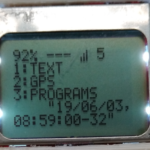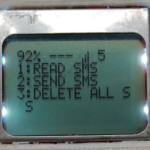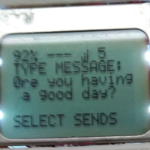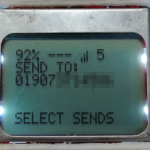Well, today is my last post on the LTE project. After showing it to my co-workers, it has now been renamed the “bone phone” because of it’s unique shape and color! I’ve also included the README.md at the end of this post with the full story.
To God be the glory, I learned a lot, and made a lot of functions with this phone. The main points are:
- Send Text messages to any valid number
- Receive and read text (SMS only) messages from anyone
- Reply or delete text messages
- Turn LTE on/off
- Turn GPS on/off
- Get your current location
- Send your current location to someone else via text
- Compass heading (must be moving to be accurate, based on GPS)
- Status Bar with battery, GPS, cellular, and messages stats
- Current local time
There was a lot more things that I wanted to do with this project. unfortunately, I ran out of memory:
Sketch uses 26938 bytes (83%) of program storage space. Maximum is 32256 bytes.
Global variables use 1567 bytes (76%) of dynamic memory, leaving 481 bytes for local variables. Maximum is 2048 bytes.
Low memory available, stability problems may occur.
As you can see from the warning, I’m running out of dynamic memory, or ram. I’ve tried adding a few more things, but anything I add tips it over the edge. Even just a few bytes added seems to make the device slow down so much that it is unusable. You are supposed to leave 512 bytes for running the program, and I’m only leaving 481, which slows it down a bit. But, be sure to check out the project on my GitLab for all the files, the pictures, videos, and 3d printer cad drawings and program! It’s all up for you to work on and improve!
Thanks for following along with me on this project! It’s been a really great learning experience! Not only that, but to God be the glory, it even works! You can read more about it in the readme if you’d like. This readme also includes operating instructions. (It’s easier to read by following the link to the mark down document, but I’ll post it here in case you need it.)
# LTE project (nickname: “Bone Phone”)
You can read more about this project on my blog: https://thealaskalinuxuser.wordpress.com
Just search for “LTE project” to see how you can build this open source hardware texting phone for yourself!This phone can send and receive text messages. Runs off of a 9 volt battery, and has six buttons.
# Operating instructions:
1. Turn on the Bone Phone by flipping the power switch to the “on” position.
2. Once it boots up, you will be presented with the main screen. On every screen, use the numbered button that corosponds to the menu item to select it.
3. Any screen that has you input text or numbers, use the buttons to navigate, 1 is up, to scroll through the numbers or letters, 2 is down, to scroll through the numbers and letters. Whatever letter or number you select is not saved to that spot until you use button 3 (left) or button 4 (right), at which point the letter/number is saved/entered.
4. Some screens tell you to push the select button (button 5) to do special functions. If needed, the screen will display the action you should take.
5. At any time, you can press the “home” button (button 6), which will take you back to the main menu.# Features
– Send/receive text messages
– Turn on/off data or gps
– View GPS location and send as text
– Compass heading screen if GPS is on
– View network info.
– Using serial over USB, you can do many more features such as download web pages, upload to the web, and more.# Notes
– I tested this with StraightTalk and Hollogram.io simcards. Both worked, but only the hollogram card would allow data if using the serial over USB connection. Both worked for texting.
– When sending a text to a number, you need either of these two formats: +19078675309 or 19078675309. Some phones will not accept unless you have the “+” sign in front of the number. So far, all phones accept the text when you use the “+” sign.
– The device has 2 batteries. One 9 volt battery, which is disposable, and non-chargable. The second battery is a 3.7 volt battery for the modem, which is charged by power from either board input or the 9 volt battery. The power battery percentage from the phone on the status bar is actually for the modem battery, and doesn’t tell you how much battery power you have left in the 9 volt battery, unfortunately.
– The serial over USB works, and you can talk to the board that way, sending and receiving texts, etc.
– The included truth table outlines the different screens and button combinations.
– The bone phone was also supposed to have a mini browser/ftp/http get/put method, as well as a game, but I ran out of memory on the device. Come on, I only had 32 kb of space and 2 kb of ram to work with!# About – Or, Why “bone phone”?
Well, the design is somewhat dog bone treat shaped, to protect the buttons. Add to that the fact that the original that I 3d printed was white, it did look like a big bone. While showing it to my co-workers one day, one of them said it’s a bone. One then said it was a bone phone. They then all started laughing and we nicknamed it the bone phone.
I built this phone so I can learn about cell phones, c and c++ programming, and work with open source open hardware on a project. This bone phone met all those goals. This bone phone cannot make phone calls, but can send or receive texts.
# Hardware Components
The main board is an Arduino Uno (or knock off), and a Botletics LTE shield, both of which are open source hardware. There is also a Nokia 5110 screen, a slider (on/off) dpst switch, and 6 momentary switches, made by QTEATAK. There were also 6 550 ohm resistors, and a 3.7v lithium cell phone battery that I took out of an old HTC sense cell phone, but any 3.7volt LiPo/Li-ion battery would do.
I also included the files for the 3d printed case that I made. I used a glue gun and glue sticks to hold most of the components and wiring in place. Please see my website for tutorials about how it was put together.
The hardware used was specifically selected because it is all open source hardware.
“Open source hardware is hardware whose design is made publicly available so that anyone can study, modify, distribute, make, and sell the design or hardware based on that design.”
# License
My portion of the software is licensed under the Apache2.0 license:
Copyright 2019 by AlaskaLinuxUser (https://thealaskalinuxuser.wordpress.com)
Licensed under the Apache License, Version 2.0 (the “License”);
you may not use this file except in compliance with the License.
You may obtain a copy of the License athttp://www.apache.org/licenses/LICENSE-2.0
Unless required by applicable law or agreed to in writing, software
distributed under the License is distributed on an “AS IS” BASIS,
WITHOUT WARRANTIES OR CONDITIONS OF ANY KIND, either express or implied.
See the License for the specific language governing permissions and
limitations under the License.
The software includes three libraries:– The Adafruit Phona Library – Written by Limor Fried/Ladyada for Adafruit Industries. BSD license, all text above must be included in any redistribution. Which was modified by Botletics, maintaining the BSD license.
– The PCD8544 Library – The MIT License (MIT), Copyright (c) 2013 Carlos Rodrigues <cefrodrigues@gmail.com>
– The Arduino software serial library – GPL2.0
Linux – keep it simple.










Hey, I just created a new community forum for people to ask questions and also to share projects they’ve done using Botletics hardware (or related things). Feel free to check it out and post under the Community Projects category if you’d like! https://community.botletics.com/
Great! I’ll check it out!